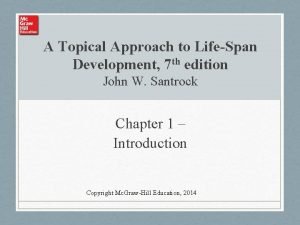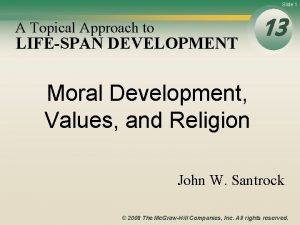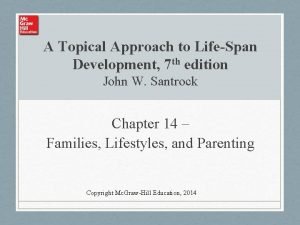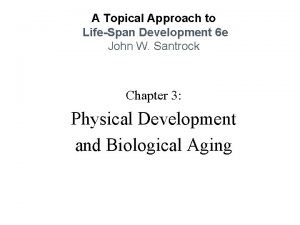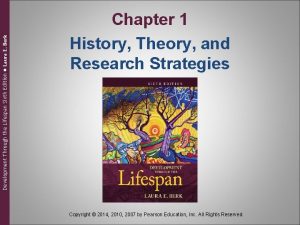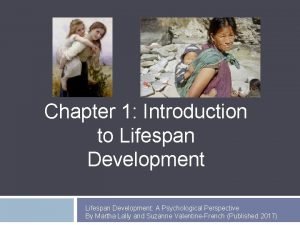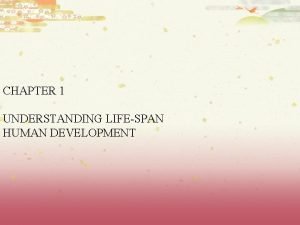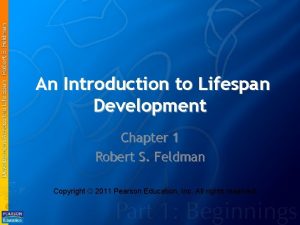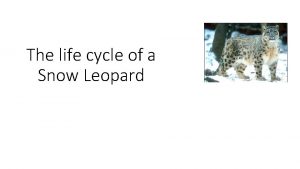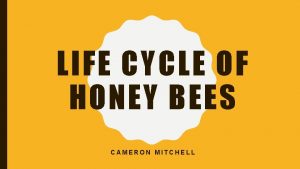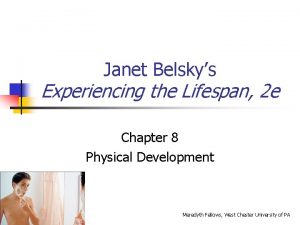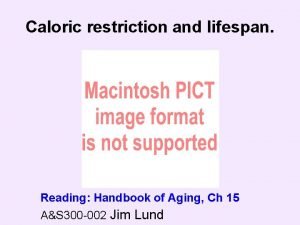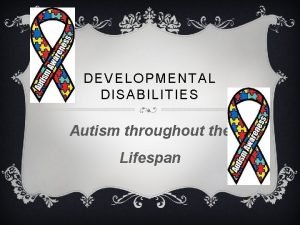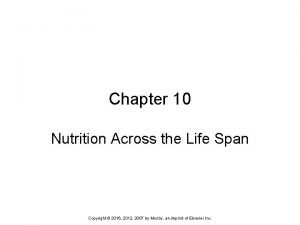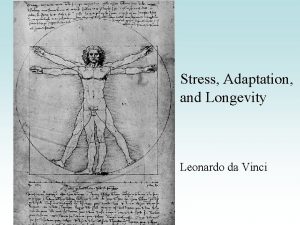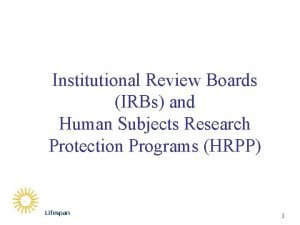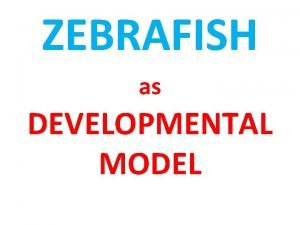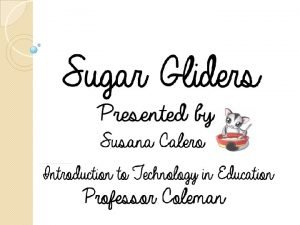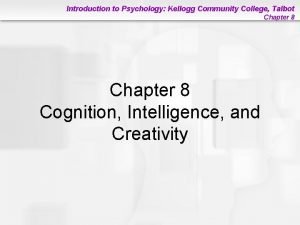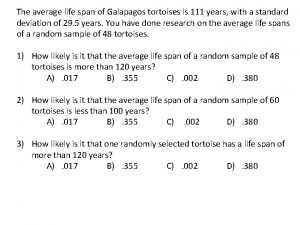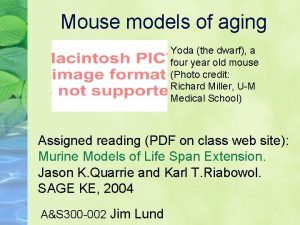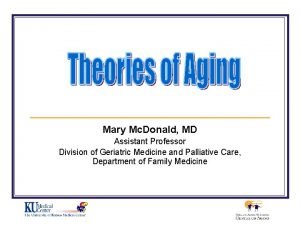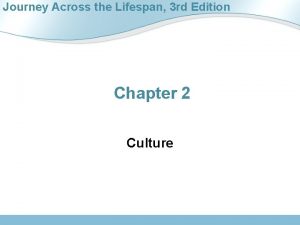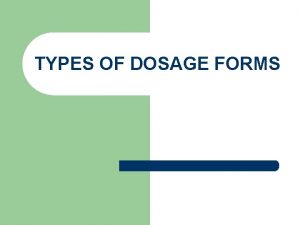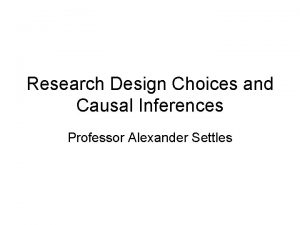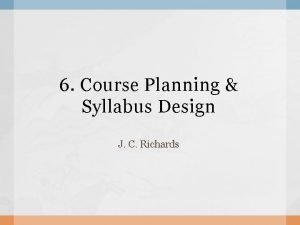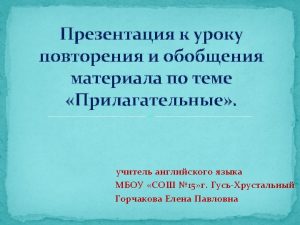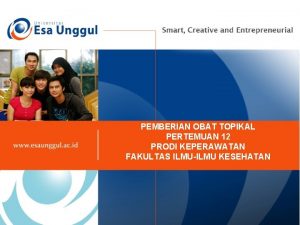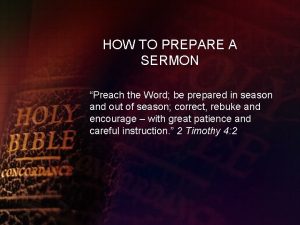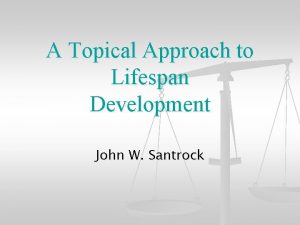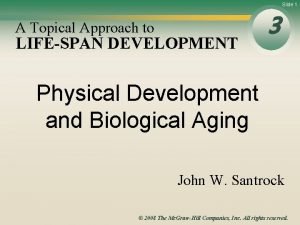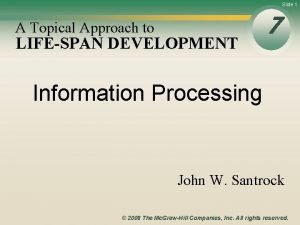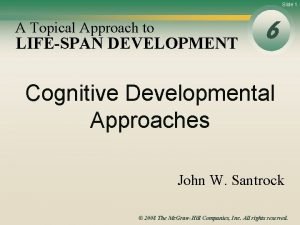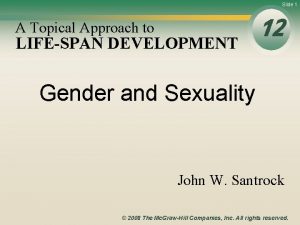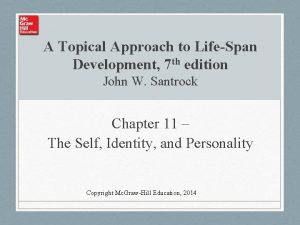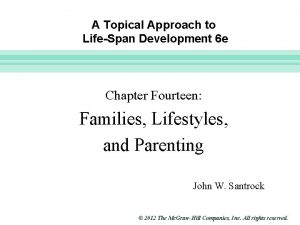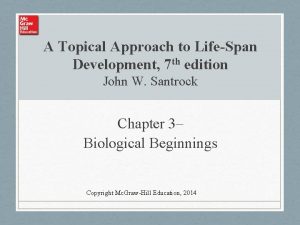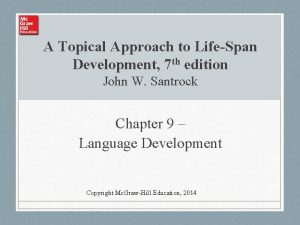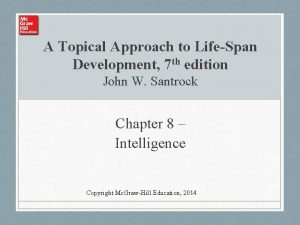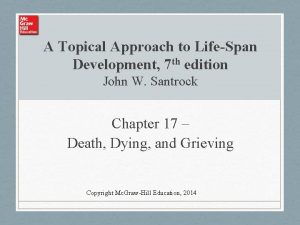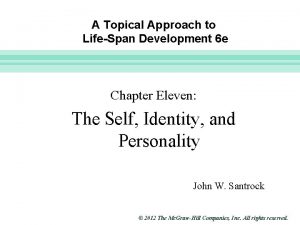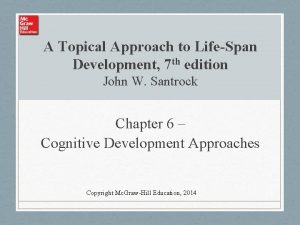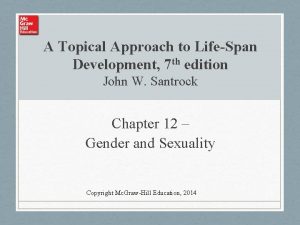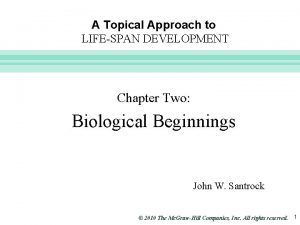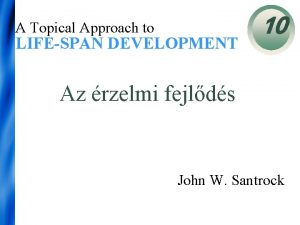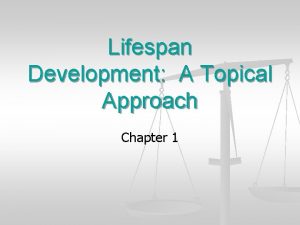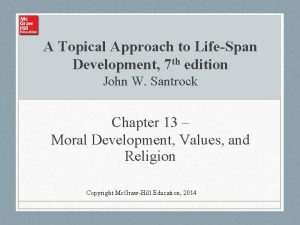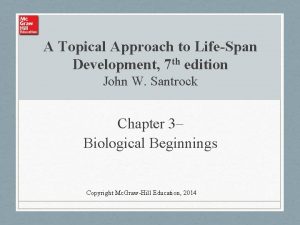A Topical Approach to Lifespan Development John W

























































- Slides: 57

A Topical Approach to Lifespan Development John W. Santrock Chapter 1: Introduction

What is Human Development? n It is a pattern of movement and change Some things change n Some things stay the same n n Movement & change include growth, transition, and decline.

The Lifespan Perspective n n History n Studied child development since about 1900. n Studied adult development since about 1960. The reason for the difference is cultural change & increased longevity (life expectancy).

Life Expectancy Changes n n Lifespan, the maximum number of years a human being could live (about 120 years) remains relatively constant. Life expectancy, the number of years a person can expect to live when born in a certain place in a certain year, changes. U. S. , 1900 47 years n U. S. , 2005, 77 years (30 year increase) n

What are the characteristics of the lifespan perspective? n Multidimensional Biological n Cognitive n Socioemotional n n Multidirectional n n Growth and decline Plastic n Potential for change

Lifespan Research is Multidisciplinary n n Where did this information come from? Research and study in many fields of endeavor including psychology, sociology, anthropology, education, and medicine.

What types of influences form the context of development? n Normative age-graded (cultural) n n Normative history-graded (historical) n n e. g. , puberty, graduation, retirement e. g. , war, famine, earthquakes, terrorism Non-normative life events & conditions (personal) n Individual experiences, biology, personality

What types of influences form the context of development? n Worldview – View of Human Nature

Historical Views of Human Nature n Prevailing views of children (human nature) throughout history? Preformationism n Original Sin n Tabula Rasa n Innate Goodness n n How does each view affect child-rearing practices?

Historical View: Preformationism n n n Time: 6 th 15 th Centuries View: Children are basically small adults without unique needs and characteristics. Effect: Little or no need for special treatment

Historical View - Original Sin n Time: 16 th Century (Puritan) View: Children are born sinful and more apt to grow up to do evil than good. Effect: Parents must discipline children to ensure morality and ultimate salvation.

Historical View - Tabula Rasa n n n Time: 17 th Century, philosopher John Locke (behaviorist) View: Children are born “blank slates” and parents can train them in any direction they wish (with little resistance). Effect: Shaping children’s behavior by reward and punishment.

Historical View – Innate Goodness n n n Time: 18 th Century, philosopher Jean Jacque Rousseau (humanist) View: Children are “noble savages” who are born with an innate sense of morality. Effect: Parents should not try to mold them at all.

What are the issues of developmental psychology? n Nature vs. nurture n Stability vs. change n Continuity vs. discontinuity

Issue 1: Nature/nurture n Nature = biological inheritance (genetics) n n Nurture = all experience n n Rousseau (humanists) Locke (tabula rasa) Is that all there is? (Is it neither? ) Are they separable? Is it both? What is epigenetic theory? n Interaction of nature and nurture

Issue 2: Stability/change n n When characteristics are biologically inherited or the result of early experiences, can they be changed? (This is the issue of plasticity again. ) Are the effects of early and late experiences equal, or are early ones more important (or later ones)?

Issue 3: Continuity/discontinuity n Did the change happen suddenly or gradually (first step; first word)? n Is there a marker event? n Does the old resemble the new (butterfly)?

What does age have to do with it? n How many ways can we conceptualize (think about) age? n Chronological age: years since birth n Biological age: health; vital organ capacity n Psychological age: adaptable; learning; flexible; good judgment n Social age: roles, expectations

What are the periods (age groups) of development? These are not standard across textbooks. However, they roughly agree. n n n Prenatal - conception to birth Infancy – birth to about 2 years Early childhood – about ages 2 -6 (preschool) Middle & late childhood – about ages 6 -11 Adolescence – ages 10 -12 or puberty until about ages 18 -22 or independence

What are the periods (age groups) of development? n Early adulthood – ages 20/25 – 40/45 n Middle adulthood – ages 40/45 – 60/65 n Late adulthood – ages 60/65 on n Young old: 65 -84 n Oldest old: 85+

To what extent are we becoming an age-irrelevant society? n People‘s lives are more varied. n We have a loose “social clock. ” n The frequency of reported happiness is about the same for all ages. (78%)

Five Theories (Perspectives) of Development Psychological n Psychoanalytic (Freud) n Cognitive n Behavioral and Social Cognitive Other n Ethological n Ecological

Psychoanalytic Theory: Erikson (1902 -1994) n Eight psychosocial stages in the lifespan Trust v. mistrust n Autonomy v. shame/doubt n Initiative v. guilt n Industry v. inferiority n Identity v. confusion n Intimacy v. isolation n Generativity v. stagnation n Integrity v. despair n

Cognitive Theories (1960 s) n n Emphasize thinking, reasoning, language Jean Piaget: Swiss (1896 -1980) Children actively construct understanding n Four stages n n Lev Vygotsky: Russian n n Knowledge is constructed through interaction with other people Information Processing n Analogy between human brain & computer

Behavioral Theories n Ivan Pavlov: Classical Conditioning Pair a neutral stimulus (CS)with a stimulus (UCS) that automatically produces a response (UCR). n John B. Watson: Emotional responses can be classically conditioned (Little Albert). n n B. F. Skinner: Operant Conditioning n Behavior followed by a reward is more likely to occur again; punished behavior is less likely to occur again.

Social-cognitive Theories n n Albert Bandura: Most social behaviors are learned by observing others, including anger, cruelty, and kindness. Reciprocal determinism: behavior, the environment, and the person (and their cognitions) mutually influence each other.

Ethological Theory n n n Based on study of animal behavior Considers the influence of biology/evolution Considers critical or sensitive periods Konrad Lorenz: imprinting-rapid, innate learning John Bowlby: attachment

Ecological Theory n n n n Urie Bronfenbrenner Emphasizes environmental concepts Microsystem: daily life Mesosystem: relates microsystems Exosystem: influences from other social systems Macrosystem: culture Chronosystem: (time) personal/social history

Review of Theories Recommendations: We will not be studying these theories directly in this course. However, their general principles may be referred to in explaining developmental events or processes. If you feel that you need to review them, I would recommend: 1. your textbook 2. any Introduction to Psychology textbook 3. www. allpsych. com 4. http: //webspace. ship. edu/cgboer/perscontents. html 5. Google the word in question, e. g. , psychoanalysis, ethology, B. F. Skinner, etc.

Why would you want to know about development? n Life planning and coping. To anticipate events and changes n To avoid known pitfalls n To understand what is happening to you n To help others in the same ways n

Why would we collectively want to know about human development? n How do we apply the results of research on lifespan development? n Parenting advice, self-help, public information. n Designing educational programs. n n Business & economic planning (e. g. , insurance sales, marketing, ). Social policy decisions (e. g. , laws on marriage, city planning, social programs such as welfare, social security, Medicare).

Social Policy Example: Does the government have/spend adequate social welfare resources on children? n Statistical Facts n n 15% of US children (almost 50% of ethnic minority children) will be raised in poverty including increased risk for stress from violence, crowding, poor housing, family turmoil, etc. Social values, beliefs, and priorities. n Parenting and nurturing the next generation of children is our society‘s most important function and we need to take it more seriously than we have in the past. Marian Edelman (Children‘s Defense Fund, 2004)

Social Policy Examples Competing needs and priorities lead to research questions? 40 -50% of US children can expect to spend at least 4 -5 years in a single-parent home. n Drug-use and AIDS are still problems n Older adults need more medical care n Generational inequity n

Data n Where do we get our data? n What information are we going to believe?

What are the techniques of collecting data? n n n Observation Survey/interview: asking questions Standardized Tests Physiological Measures Case Study Life-history records

What are the techniques of collecting data? n Observation Laboratory n Naturalistic n People act/react differently when they know they are being watched. n

What are the techniques of collecting data? n Survey/interview: asking questions Unstructured/open-ended n Structured, quantitative n Ask the right questions of the right people. n

What are the techniques of collecting data? n Standardized tests: comparison of performance with others Remember tests are cultural and they do not predict behavior in non-test situations. n You may also have difficulty finding a test that measures your variable of interest. n

What are the techniques of collecting data? n Physiological measures: hormones in blood; neurological measures (PET; f. MRI) n Remember there is never a one-to-one relationship between a physiological measure and a psychological state.

What are the techniques of collecting data? n n Case study: intensive, in-depth study of a single case as with a physician-patient or therapist-patient relationship. Good for gaining insight. Life-history records: education, work, medical, family

Research Designs n n Descriptive – includes more detail Correlational – numbers show strength & direction of relationship Used for prediction n Ranges from -1. 00 to +1. 00 (+ is direct; - is inverse) n n Remember: correlation does not equal causation

Experiments n Manipulation in experiments means there is different treatment in different groups. The experimental group experiences the “real” treatment or manipulation. n Control groups do not; they are for comparison. (“Placebo” controls get a fake treatment. ) n Random assignment of participants to groups ensures that groups start out the same. n

Experiments Provide Evidence of Cause-Effect Relationships n n n This is because of control and manipulation. One situational factor (Independent Variable) is manipulated. A behavior (Dependent Variable) is measured. All other factors are “held constant” or the same in all groups. (This is control. ) A change in the dependent variable (behavior) could only be caused by manipulation of the independent variable because all else was controlled.

Research on How People Change across the Lifespan n Cross-sectional research: People of different ages are measured in the same year. n Cohort effects may occur. These are differences due not to common age, but common experience n Longitudinal research: The same people are repeatedly measured across different years. n Expensive, time-consuming, dropouts

Research on How People Change across the Lifespan n Sequential or cross-sequential research: a combination of cross-sectional and longitudinal n People of different ages are measure the first year. Then at intervals (e. g. , 1, 5, 10 years), the same people are measured again and new groups are added.

How Do We Know? Or Do We Just Believe? n We are information dependent Bandura – learn from observing others n Vygotsky – learn through conversation/communication with others n n What is the world’s tallest mountain? n Why do you believe that it is Everest?

How Do We Know? Or Do We Just Believe? n Robyn Dawes n Why believe that for which there is no good evidence? n n n http: //www. fmsonline. org/dawes. html (Or possibly evidence to the contrary? ) Most of what we know, we actually believe that we know from authority and consensus.

How Do We Know? Or Do We Just Believe? n Authority implies that the knowledge is reliable Source is trustworthy n No ulterior motives n Possibly a good reputation n In position to have this type of knowledge n n However, we often attribute this to consistency of report/public exposure (media).

How Do We Know? Or Do We Just Believe? n Consensus leads to lack of doubt. n n (Surely somebody would know if this is false. ) The fallacy in consensus is that if the same misinformation (lie) is told often enough, everyone believes it for the truth. n Becomes “common sense” (common nonsense)

How Do We Know? Or Do We Just Believe? n Ways to Know Include Authoritative sources n Opinions of others (consistent or not) n Personal experience n Intuition (with or without confirmation) n Reason (I figured it out. ) n Common sense n Data n

Consider the Limitations of Data Some things cannot be measured, or detected by the five senses n Some variables cannot be ethically or possibly submitted to experimentation, only correlation n This will not show causality. n Correlations may be spurious. n There may have been bias in data collection. n The interpretation may be incorrect. n Information for public consumption may be less accurate. n

How Do We Know? Or Do We Just Believe? n In our culture data trumps other sources Recorded evidence, we can all agree n May not agree in Interpretation n n Tend to discount “pre-scientific” claims to knowledge/understanding n We even discount “old” data.

How Do We Know? Or Do We Just Believe? n This tends to lead to bias against non-data sources, earlier historical times, and less industrialized civilizations. “So easy a cave man could do it. ” n Don’t bother to study history. n

How Do We Know? Or Do We Just Believe? n Led to the postmodern mindset Truth is relative to the situation and changes across time. n There is no ultimate truth that is unchanging. n No reliable causes and effects. n Reality is socially constructed. n n Idea that we create knowledge and reality, and it is what we say it is. n Hence, we can change it.

How Do We Know? Or Do We Just Believe? n Contrast the prisca sapientia view. Was there a pristine and superior ancient knowledge? n How else do you explain the writings of the ancient Greeks, Egyptians, and Hebrews? n How to you explain the Mayan calendar and the construction of the Egyptian pyramids? n How was it lost? n Did the search for it lead to modern science? n

How Do We Know? Or Do We Just Believe? n Contrast the prisca sapientia view. n The existence of this knowledge would imply a fixed and unchanging set of principles for operation of the universe and the natural world, including the biological world, and possibly for human nature and the social world.

Practical Critical Thinking n n n n 1. Stop to think. 2. Theories are not proven facts. 3. Findings of research can be misinterpreted. 4. Correlations are not evidence of causation. 5. Be very suspicious of politicized research. 6. Beware journalistic media as a source of presentation of scientific findings. 7. Always ask whether the topic is more likely a law or principle rather than a social convention.
 A topical approach to lifespan development
A topical approach to lifespan development Topical approach definition
Topical approach definition Topical approach definition
Topical approach definition Topical approach definition
Topical approach definition Development through the lifespan 6th edition
Development through the lifespan 6th edition Lifespan development a psychological perspective
Lifespan development a psychological perspective Chapter 9 lifespan development
Chapter 9 lifespan development Physical development
Physical development Ul guidance counselling
Ul guidance counselling Lifespan development third edition
Lifespan development third edition Lifespan development third edition
Lifespan development third edition Exploring lifespan development chapter 1
Exploring lifespan development chapter 1 Sociocultural graded influences
Sociocultural graded influences Lifecycle of a snow leopard
Lifecycle of a snow leopard What does a gulper eel eat
What does a gulper eel eat Prepare and display petit fours pdf
Prepare and display petit fours pdf Splendour beetle lifespan
Splendour beetle lifespan Honeybee lifecycle
Honeybee lifecycle Ponce de leon nationality
Ponce de leon nationality Janet belsky
Janet belsky Henry hudson
Henry hudson Lifespan of every animal
Lifespan of every animal The developing person through the lifespan
The developing person through the lifespan Prairie dog adaptations
Prairie dog adaptations Autism lifespan
Autism lifespan Chapter 10 nutrition
Chapter 10 nutrition Eagle lifespan
Eagle lifespan Da vinci lifespan
Da vinci lifespan Lifespan irb
Lifespan irb Henry hudson fun facts
Henry hudson fun facts Man o war habitat
Man o war habitat Lifespan of platelets
Lifespan of platelets Nudibranch lifespan
Nudibranch lifespan Life cycle of zebrafish
Life cycle of zebrafish Can sugar gliders eat beets
Can sugar gliders eat beets What are the barriers to problem-solving in psychology
What are the barriers to problem-solving in psychology Galapagos turtle lifespan
Galapagos turtle lifespan Yoda lifespan
Yoda lifespan Mary quiceno md
Mary quiceno md Journey across the lifespan
Journey across the lifespan Lifespan corn snake
Lifespan corn snake Topical order literature review
Topical order literature review Douche dosage form
Douche dosage form Water removable bases
Water removable bases Topical agents definition
Topical agents definition Types of syllabus
Types of syllabus Topical scope
Topical scope Intravenous medication administration pretest
Intravenous medication administration pretest Topical dosage forms
Topical dosage forms Situational syllabus example
Situational syllabus example Topical vocabulary
Topical vocabulary Makalah pemberian obat topikal
Makalah pemberian obat topikal Ati injectable medication administration posttest
Ati injectable medication administration posttest How to prepare to preach the word of god
How to prepare to preach the word of god Evaluation of paste
Evaluation of paste Define dosage form
Define dosage form Topical routes
Topical routes Topical pattern of arrangement
Topical pattern of arrangement
